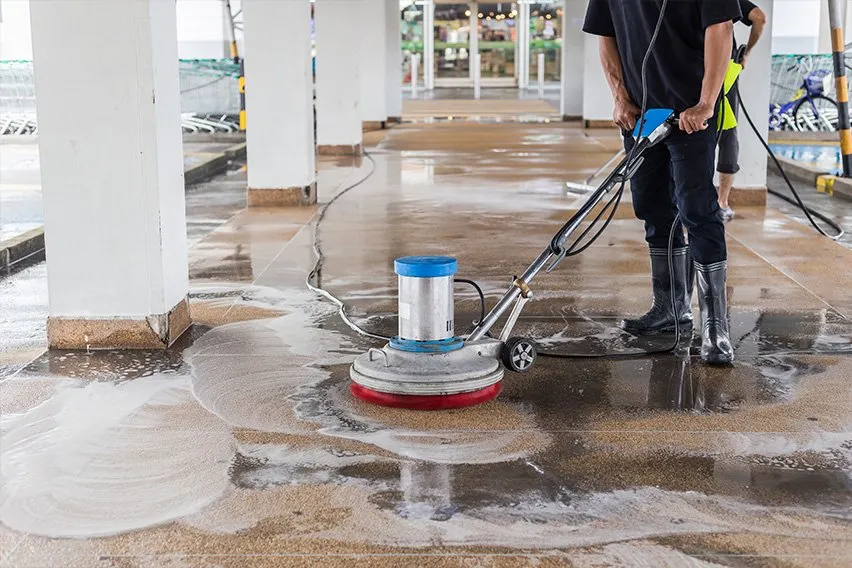How much psi needed to clean concrete? To determine it depends on the type of concrete surface and the level of cleaning required. Generally, for light-duty cleaning, a pressure washer with 2,000 to 2,500 PSI is sufficient. For medium-duty cleaning, 2,500 to 3,000 PSI is recommended, and for heavy-duty cleaning, 3,000 to 4,000 PSI or higher may be needed
The high pressure helps to dislodge and remove tough stains and debris from the concrete surface. Lower pressure settings may not be sufficient to achieve a thorough clean. However, it is important to note that the appropriate psi will depend on the specific condition and type of concrete to be cleaned.
It is always recommended to consult the equipment manufacturer’s guidelines and test a small area before starting the cleaning process to ensure optimal results and prevent damage to the concrete surface.

Credit: www.freshbooks.com
What Is Power Cleaning And Why Is Psi Important?
Power cleaning is a method used to effectively clean concrete surfaces using high-pressure water. Psi (pounds per square inch) is important as it determines the cleaning power and should be around 3000-4000 psi for optimal results.
Definition Of Power Cleaning:
Power cleaning, also known as pressure washing, refers to the process of utilizing a high-pressure water spray to remove dirt, grime, mold, mildew, and other stubborn stains from concrete surfaces. This method involves the use of specialized equipment, powered by either gas or electricity, to generate high water pressure, measured in psi (pounds per square inch).
The psi determines the force with which the water is expelled from the nozzle, making power cleaning an effective technique for restoring the appearance and integrity of concrete surfaces.
Benefits Of Power Cleaning Concrete Surfaces:
Power cleaning concrete surfaces offers several benefits, including:
- Enhanced visual appeal: Over time, concrete surfaces can accumulate dirt, stains, and discoloration. Power cleaning effectively eliminates these unsightly blemishes, significantly enhancing the visual appeal of sidewalks, driveways, decks, and patios.
- Prevention of structural damage: Regular power cleaning helps prevent the buildup of mold, mildew, and other contaminants that can cause irreversible damage to concrete surfaces. By removing these elements, power cleaning safeguards the structural integrity and longevity of the concrete.
- Improved safety: Concrete surfaces can become slippery and unsafe when coated with moss, algae, or other slippery substances. By power cleaning these surfaces, you can eliminate these hazards, reducing the risk of slips and falls.
- Time and cost efficiency: Power cleaning provides an efficient and cost-effective solution for cleaning concrete surfaces. It eliminates the need for labor-intensive manual scrubbing and reduces the time required to achieve a thorough clean.
- Environmentally friendly: Power cleaning offers an eco-friendly alternative to harsh chemical cleaners. By relying on the force of high-pressure water, power cleaning minimizes the use of chemicals, making it a more environmentally sustainable option.
The Role Of Psi In Power Cleaning Effectiveness:
The psi measurement plays a crucial role in determining the effectiveness of power cleaning. Here’s why psi is important:
- Cleaning power: The psi level directly correlates to the force with which the water is sprayed onto the concrete surface. Higher psi translates to greater cleaning power, making it easier to remove stubborn stains and grime.
- Versatility: Different concrete surfaces require varying psi levels to achieve optimal cleaning results. Some surfaces, such as delicate decorative concrete, may require lower psi to avoid damage, while heavily stained surfaces may require higher psi for thorough cleaning.
- Efficiency: A balance must be struck between adequate cleaning power and potential damage to the concrete surface. Using the appropriate psi ensures efficient cleaning without causing any harm.
- Avoiding damage: Excessive psi can cause damage to the concrete, such as etching or surface pitting. It is crucial to follow manufacturer guidelines and consult professionals to determine the appropriate psi range for specific concrete surfaces.
- Safety considerations: When using high psi power cleaning equipment, it’s essential to follow safety precautions, such as wearing protective gear and maintaining a safe distance from the surface being cleaned. Understanding psi helps ensure safe and effective power cleaning practices.
By understanding the definition of power cleaning, the benefits it offers, and the role of psi in its effectiveness, you can make informed decisions when it comes to cleaning and maintaining concrete surfaces. Remember to always prioritize safety and consult experts if needed, to effectively restore and protect your concrete.
Understanding The Psi Requirement For Different Concrete Surfaces
Learn the essential psi requirement for cleaning concrete surfaces effectively. Discover the optimal pressure needed to achieve excellent results without causing damage or deterioration.
Concrete surfaces require a specific amount of pressure to effectively clean them. This pressure is measured in pounds per square inch (psi). Understanding the psi requirement for different concrete surfaces is crucial to ensure a thorough and efficient cleaning process.
Factors such as the type of surface, its condition, and the desired outcome influence the psi requirement. Let’s delve into these factors and explore the typical psi ranges for various concrete surfaces.
Factors Influencing The Psi Requirement:
- Surface type: Different concrete surfaces have varying durability and sensitivity levels. Factors like the age, composition, and thickness of the concrete influence the psi requirement.
- Surface condition: The level of dirt, stains, or grime present on the concrete surface can determine the appropriate psi. Heavily soiled surfaces may require higher pressure, whereas less dirty surfaces may need lower psi for effective cleaning.
- Coatings or sealants: If the concrete surface has any coatings or sealants, the psi requirement needs to accommodate their presence. High pressure could damage or remove these protective layers, so it is essential to consider their presence.
- Desired outcome: The objective of cleaning the concrete surface also affects the psi requirement. For example, if the goal is to remove surface stains, a lower psi might be sufficient. However, if deep cleaning or paint removal is necessary, higher psi may be required.
Typical Psi Ranges For Various Concrete Surfaces:
- Driveways and sidewalks: 2500-3500 psi
- Patios and pool decks: 2000-2500 psi
- Garage floors: 1500-2000 psi
- Concrete walls: 3000-4000 psi
Importance Of Adjusting Psi Based On Surface Condition:
Adapting the psi based on the condition of the concrete surface is paramount to avoid unintended damage. Here’s why it matters:
- Preventing surface chipping: Using excessive psi on delicate or aged concrete can cause chipping or pitting, compromising the integrity of the surface.
- Minimizing etching or streaking: Inappropriate psi levels can lead to surface etching or streaking, where the high pressure removes some areas of the concrete more than others. This can result in an uneven or unattractive appearance.
- Ensuring effective cleaning: Adjusting the psi based on the surface condition ensures that the cleaning process is efficient and achieves the desired results. Using the correct psi prevents under cleaning or leaving behind stubborn stains or grime.
Remember, it is essential to use the appropriate psi while cleaning different concrete surfaces to ensure their longevity and aesthetic appeal. By understanding the factors influencing the psi requirement and adjusting it based on the surface condition, you can achieve optimal cleaning results.
Determining The Optimal Psi For Power Cleaning Concrete Surfaces
Determining the optimal psi for power cleaning concrete surfaces is crucial when seeking the right amount of pressure needed to effectively clean. Achieving the desired results relies on finding the right balance to effectively remove dirt, grime, and stains without damaging the concrete.
Cleaning concrete surfaces can be a challenging task, especially if you don’t have the right equipment and techniques. One crucial factor to consider when power cleaning concrete is the optimal psi (pounds per square inch) to use. The psi determines the level of pressure exerted by the power cleaning equipment, which directly influences the effectiveness of removing dirt, grime, and stains from the surface.
Here are some key considerations for determining the optimal psi for power cleaning concrete surfaces:
Evaluating The Level Of Dirt And Grime On The Surface:
- Take a close look at the concrete surface to assess the amount of dirt, grime, and stains present. This evaluation will help you determine the level of cleaning power required.
- Pay attention to areas with embedded dirt or deeply ingrained stains, as they may need higher psi settings to achieve satisfactory results.
- Identify any mildew, algae, or mold growth on the surface, as these contaminants may require higher psi and the use of appropriate cleaning solutions.
Considering The Age And Durability Of The Concrete:
- Evaluate the age and condition of the concrete to prevent potential damage caused by excessive pressure. Older or more delicate concrete surfaces can be more prone to cracking or crumbling under high psi settings.
- Determine the strength and durability of the concrete surface. If it’s highly compacted and in good condition, higher psi settings can be applied. However, if the concrete is in poor condition or shows signs of deterioration, lower psi settings are advisable.
Matching The Psi To The Specific Power Cleaning Equipment Being Used:
- Different power cleaning equipment comes with varying psi capabilities. It’s crucial to match the psi requirement of the equipment to the needs of the concrete surface.
- Read the manufacturer’s guidelines and specifications for the power cleaning equipment to determine the recommended psi range for optimal results.
- Adjust the psi settings based on the size and type of nozzle being used. Smaller nozzles generally require higher psi settings for concentrated cleaning power, while larger nozzles may require lower psi settings for broader coverage.
Remember to take appropriate safety precautions, such as wearing protective gear and maintaining a safe distance from the surface being cleaned. By properly evaluating the level of dirt and grime, considering the age and durability of the concrete, and matching the psi to the power cleaning equipment, you can ensure effective and efficient cleaning of concrete surfaces.
So, gear up, determine the optimal psi, and get ready to power clean those concrete areas to perfection!
How To Safely Achieve The Required Psi For Effective Power Cleaning
To achieve effective power cleaning on concrete surfaces, it is essential to know the required psi. This ensures safe and thorough cleaning, removing dirt and grime effectively. By following the recommended psi guidelines, you can achieve optimal results without causing any damage.
Selection of the right power washer:
- Consider the power rating and flow rate: Opt for a power washer with sufficient power and flow rate to meet the required psi for cleaning concrete effectively.
- Gas or electric: Evaluate the pros and cons of gas and electric power washers and select the one that suits your needs and preferences.
- Portable or stationary: Determine whether a portable or stationary power washer best fits your cleaning requirements and makes it easier to achieve the desired psi.
Adjusting nozzle size and spray angle for optimal psi:
- Nozzle selection: Use a nozzle with a suitable orifice size to obtain the desired psi for concrete cleaning.
- Narrow or wide spray angle: Adjust the spray angle of the nozzle based on the surface area and level of debris on the concrete. A narrow spray angle concentrates the pressure, while a wider angle covers more area.
Implementing proper technique and precautions for safety:
- Maintain distance: Keep a safe distance between the power washer nozzle and the concrete surface to avoid causing damage.
- Even pressure application: Maintain a consistent distance between the nozzle and the concrete, moving in a steady, sweeping motion to achieve uniform cleaning.
- Protective gear: Remember to wear protective gear, such as safety goggles and gloves, to shield yourself from any potential debris or splashing water.
- Test on a small area first: Before utilizing the power washer on the entire concrete surface, test it on a small inconspicuous area to ensure the pressure and spray pattern are suitable.
When cleaning concrete, it is crucial to select the right power washer, adjust the nozzle size and spray angle appropriately, and employ proper technique and safety precautions. By following these guidelines, you can achieve the required psi for effective power cleaning without causing any damage.
Maintenance And Longevity Of Concrete Surfaces With Proper Psi
Proper psi is crucial for cleaning concrete surfaces to ensure maintenance and longevity. With the right pressure, you can effectively remove dirt and stains without damaging the surface, keeping it looking pristine for years to come.
Concrete surfaces, while durable and long-lasting, require regular maintenance to ensure their longevity. One crucial aspect of maintaining concrete surfaces is using the correct amount of psi (pounds per square inch) for cleaning. Too much psi can cause damage to the concrete, while inadequate psi may result in ineffective cleaning.
In this section, we will discuss how to avoid damaging the concrete through excessive psi and provide tips for cleaning concrete surfaces without compromising their integrity. Additionally, we will explore how regular power cleaning can enhance the lifespan of concrete surfaces.
Avoiding Damage To The Concrete Through Excessive Psi:
- Start by assessing the condition of your concrete surface and the level of dirt or stains present.
- Determine the appropriate psi range for cleaning your specific type of concrete. This information can usually be found in your pressure washer’s user manual or by contacting the manufacturer.
- Avoid using high-pressure nozzles or settings that exceed the recommended psi range, as this can lead to surface erosion, chipping, or even cracks in the concrete.
- Gradually increase the psi level if stubborn stains persist, rather than immediately resorting to maximum pressure.
- Keep the spray nozzle at a safe distance from the concrete surface, typically around 12 inches or as recommended by the pressure washer manufacturer.
- Use wide-angle spray nozzles or attachments to evenly distribute the cleaning pressure and minimize the risk of concentrated damage.
Tips For Cleaning Concrete Surfaces Without Compromising Their Integrity:
- Sweep the concrete surface thoroughly beforehand to remove loose debris and dirt.
- Pre-treat any oil or grease stains with a suitable degreaser before applying pressure washing.
- Apply a concrete cleaning solution or detergent specifically formulated for pressure washing to maximize the cleaning effectiveness.
- Work in sections, starting from one end of the concrete and moving methodically across the entire surface.
- Keep the spray wand moving continuously to prevent etching or gouging the concrete.
- Rinse the concrete surface thoroughly after cleaning to remove any remaining detergent or residue.
- For stubborn stains, use a scrub brush or rotary surface cleaner attachment to agitate and lift the dirt or grime before pressure washing.
- Consider using a lower psi setting in combination with a surface cleaner attachment for regular maintenance cleaning, as this reduces the risk of damage while still achieving satisfactory results.
Enhancing The Lifespan Of Concrete Surfaces Through Regular Power Cleaning:
- Regular power cleaning can effectively remove dirt, algae, mold, and other contaminants that can deteriorate the appearance and integrity of concrete surfaces over time.
- By removing these deposits, power cleaning helps prevent the growth of unwanted vegetation and reduces the risk of slip and fall accidents.
- The process of power cleaning also helps maintain the original color and texture of the concrete, preserving its aesthetic appeal.
- When conducted at appropriate intervals, power cleaning can extend the lifespan of concrete surfaces by preventing the accumulation of harmful substances and maintaining a clean and well-maintained appearance.
- Consider scheduling power cleaning sessions annually or as needed based on the level of dirt and usage of the concrete surface.
Maintaining concrete surfaces requires a delicate balance between effective cleaning and preventing damage. By following the recommended psi guidelines, implementing proper cleaning techniques, and conducting regular power cleaning, you can ensure the longevity and durability of your concrete surfaces.
Frequently Asked Questions Of How Much Psi Needed To Clean Concrete
What Is The Recommended Psi For Cleaning Concrete?
The recommended psi for cleaning concrete is typically between 2000 to 3000 psi. This level of pressure is effective in removing dirt, grime, and stains from the surface without causing damage. However, it’s always best to consult the manufacturer’s guidelines for your specific cleaning equipment and concrete type.
Can A Pressure Washer With Lower Psi Clean Concrete Effectively?
A pressure washer with lower psi may still be able to clean concrete, but it may require more time and effort. Lower psi machines can still remove surface dirt and debris, but they may struggle with deep-seated stains and stubborn grime.
If you have a lower psi pressure washer, consider using appropriate cleaning agents and allowing more time for the cleaning process.
What Happens If I Use Too High Psi To Clean Concrete?
Using too high psi to clean concrete can cause damage to the surface. Excessive pressure can result in etching, chipping, or even cracking of the concrete. It’s important to use the appropriate pressure for the specific cleaning task to avoid potential damage.
A professional concrete cleaner can help determine the ideal psi for your cleaning needs.
Are There Any Safety Precautions I Should Take When Cleaning Concrete With A Pressure Washer?
Yes, it’s important to follow safety precautions when cleaning concrete with a pressure washer. Wear protective gear such as goggles, gloves, and sturdy footwear. Keep the pressure washer wand pointed away from yourself and others to prevent injury. Avoid using excessive pressure or getting too close to the surface to prevent damage.
Also, protect nearby plants and objects from overspray or debris.
Can I Use A Pressure Washer To Remove Oil Stains From Concrete?
Yes, a pressure washer can be effective in removing oil stains from concrete. However, it may require additional steps, such as using a degreaser or concrete cleaner specifically designed for oil stains. Apply the cleaning agent to the stained area, let it sit for a while, and then use the pressure washer to rinse away the stain.
Repeat the process if necessary.
Is It Necessary To Use Hot Water With A Pressure Washer To Clean Concrete?
Using hot water with a pressure washer can help improve the cleaning effectiveness, especially for removing tough stains or grease. However, it is not always necessary. Cold water pressure washers can still do a decent job of cleaning concrete surfaces.
Consider the nature of the stains and the equipment you have at hand to determine if hot water is required.
Conclusion
Cleaning concrete requires the right amount of pressure to achieve optimal results. By understanding the right psi needed, you can effectively remove stubborn stains, dirt, and grime from your concrete surfaces. Whether you’re cleaning your driveway, patio, or garage floor, the right pressure will ensure a thorough and efficient cleaning process.
Not only will this improve the appearance of your concrete, but it will also extend its lifespan by removing any contaminants that could potentially cause damage. Remember, using too high of a psi can result in damage to the concrete, so it’s important to find a balance.
By following the recommended psi guidelines for different concrete surfaces, you can safely and effectively clean your concrete and maintain its longevity. So, before you start your next concrete cleaning project, make sure you have the right psi for the job at hand.
Sources of Information:

“My name is Leo Jacob, and I hold a Bachelor of Science degree with Honors in Applied Environmental Science and Sustainability from the University of the West of Scotland. Since childhood, I’ve been passionate about living an eco-friendly life. After completing my studies, I dedicated myself to finding simple ways to lead a more environmentally conscious lifestyle. I launched ecolifely.com to share my educational background and practical experiences with everyone, hoping to inspire others to join me in creating a greener, more sustainable world.”










